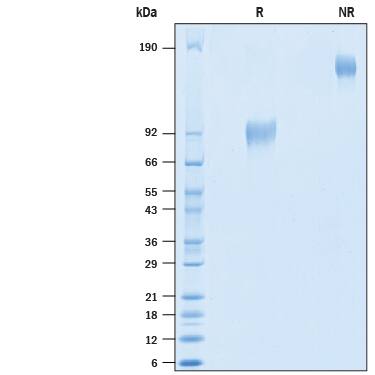Recombinant Human Embigin/EMB Fc Chimera Protein CF
R&D Systems, part of Bio-Techne | Catalog # 10832-EM

Key Product Details
Source
Accession #
Structure / Form
Conjugate
Applications
Product Specifications
Source
| Human Embigin/EMB (Asp33-Pro260) Accession # Q6PCB8.1 |
IEGRMD | Human IgG1 (Pro100-Lys330) |
| N-terminus | C-terminus |
Purity
Endotoxin Level
N-terminal Sequence Analysis
Predicted Molecular Mass
SDS-PAGE
Activity
Recombinant Human Embigin/EMB Fc Chimera, immobilized at 2.5 μg/mL on a 96 well plate, is able to significantly inhibit neurite outgrowth.
Scientific Data Images for Recombinant Human Embigin/EMB Fc Chimera Protein CF
Recombinant Human Embigin/EMB Fc Chimera Protein SDS-PAGE.
2 μg/lane of Recombinant Human Embigin/EMB Fc Chimera (Catalog # 10832-EM) was resolved with SDS-PAGE under reducing (R) and non-reducing (NR) conditions and visualized by Coomassie® Blue staining, showing bands at 85-100 kDa and 170-200 kDa, respectively.Formulation, Preparation and Storage
10832-EM
| Formulation | Lyophilized from a 0.2 μm filtered solution in PBS. |
| Reconstitution | Reconstitute at 500 μg/mL in PBS. |
| Shipping | The product is shipped at ambient temperature. Upon receipt, store it immediately at the temperature recommended below. |
| Stability & Storage | Use a manual defrost freezer and avoid repeated freeze-thaw cycles.
|
Background: Embigin/EMB
Embigin (EMB) is a transmembrane glycoprotein belonging to the immunoglobulin superfamily (IgSF) proteins. It is a cell adhesion molecule that is preferentially expressed during mouse embryogenesis (1). Embigin, along with basigin and neuroplastin, form a small subgroup within the IgSF, with all members possessing a glutamate at the same position in the transmembrane domain (2). Mature, human Embigin is highly glycosylated and consists of an extracellular domain (ECD) wjth two Ig domains, a transmembrane region, and a short intracellular region. Within the ECD, human EMB shares 75% and 62% amino acid identity with mouse and rat EMB, respectively. Embigin is an accessory protein of monocarboxylic acid transporter, MCT2 which participates in transporting lactic acid between glial cells and neurons (3). Thus, it may be related to brain energy metabolism and has been investigated as a susceptible gene for schizophrenia (4). Embigin is highly expressed in early embryos of mice, and in the heart, lung, brain and other tissues of adult rats (5, 6). Loss of embigin promotes proliferation, anchorage-independent growth, and migration ability of breast cancer cells (7).
References
- Fan, Q.W. et al. (1998) Dev. Growth Differ. 40:277.
- Muramatsu, T, and Miyauchi, T. (2003) Histol. Histopathol. 18:981.
- Perez-Escuredo, J. et al. (2016) Biochim. Biophys. Acta 863:2481.
- Zhou, J. et al. (2020) BMC Psychiatry 20:135.
- Huang, R. et al. (1990) Differentiation 45:76.
- Guenette, R. et al. (1997) Dev. Genet. 4:268.
- Chao, F. et al. (2015) Oncotarget 6:23496.
Alternate Names
Gene Symbol
UniProt
Additional Embigin/EMB Products
Product Documents for Recombinant Human Embigin/EMB Fc Chimera Protein CF
Product Specific Notices for Recombinant Human Embigin/EMB Fc Chimera Protein CF
For research use only
